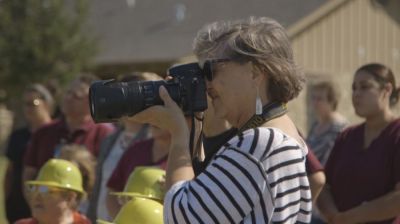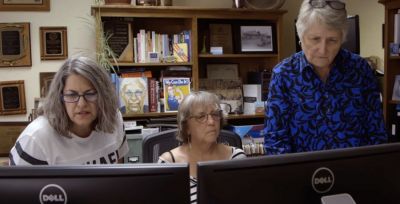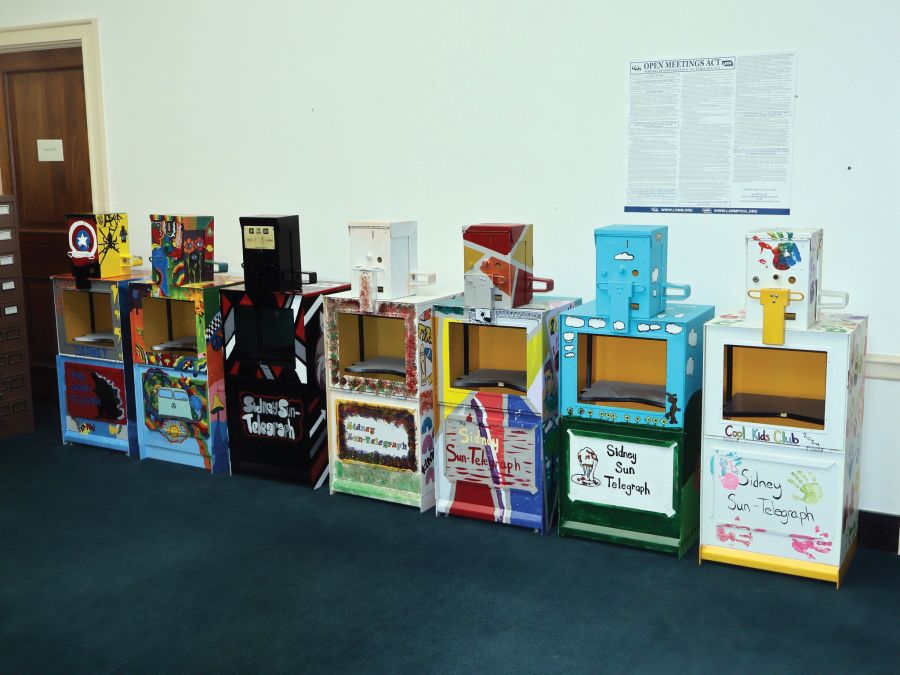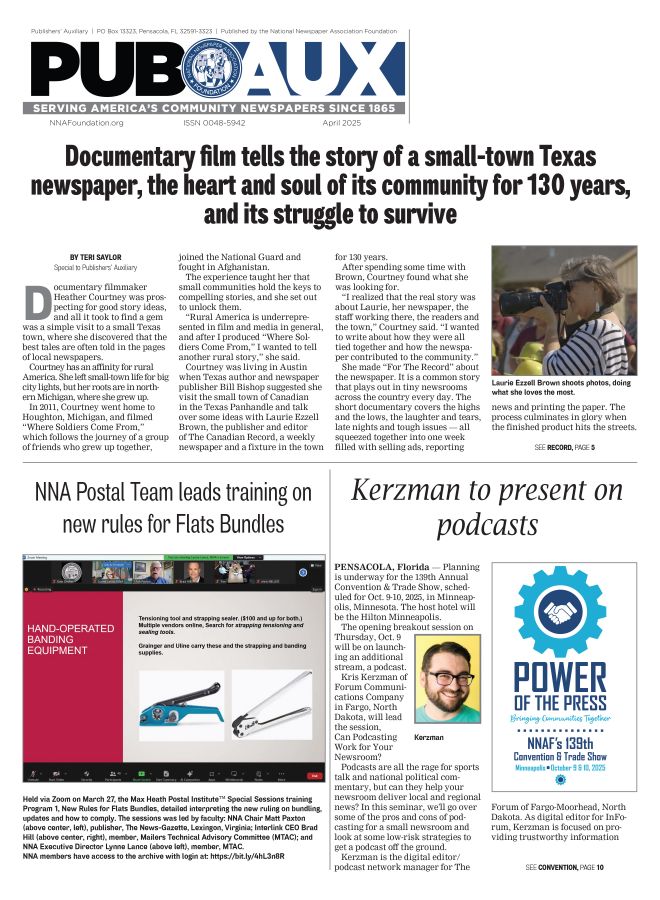Documentary film tells the story of a small-town Texas newspaper, the heart and soul of its community for 130 years, and its struggle to survive
Teri Saylor
Special to Publishers' Auxiliary
Apr 1, 2025




Documentary filmmaker Heather Courtney was prospecting for good story ideas, and all it took to find a gem was a simple visit to a small Texas town, where she discovered that the best tales are often told in the pages of local newspapers.
Courtney has an affinity for rural America. She left small-town life for big city lights, but her roots are in northern Michigan, where she grew up.
In 2011, Courtney went home to Houghton, Michigan, and filmed “Where Soldiers Come From,” which follows the journey of a group of friends who grew up together, joined the National Guard and fought in Afghanistan.
The experience taught her that small communities hold the keys to compelling stories, and she set out to unlock them.
“Rural America is underrepresented in film and media in general, and after I produced “Where Soldiers Come From,” I wanted to tell another rural story,” she said.
Courtney was living in Austin when Texas author and newspaper publisher Bill Bishop suggested she visit the small town of Canadian in the Texas Panhandle and talk over some ideas with Laurie Ezzell Brown, the publisher and editor of The Canadian Record, a weekly newspaper and a fixture in the town for 130 years.
After spending some time with Brown, Courtney found what she was looking for.
“I realized that the real story was about Laurie, her newspaper, the staff working there, the readers and the town,” Courtney said. “I wanted to write about how they were all tied together and how the newspaper contributed to the community.”
She made “For The Record” about the newspaper. It is a common story that plays out in tiny newsrooms across the country every day. The short documentary covers the highs and the lows, the laughter and tears, late nights and tough issues — all squeezed together into one week filled with selling ads, reporting news and printing the paper. The process culminates in glory when the finished product hits the streets.
And the next day, it starts all over again.
What the documentary doesn’t show is the newspaper’s closing — two weeks after the film premiered at the Big Sky Film Festival in Montana on Feb. 18, 2023.
THE CANADIAN RECORD
Like many publishers and editors who grew up in a newspaper family, Brown was raised on ink and newsprint.
Her parents, Ben and Nancy Ezzell, bought The Canadian Record in 1948 when the newspaper was 55 years old. Launched in 1893, it was celebrating its 130th anniversary when Brown turned off the lights on March 2, 2023.
Canadian, Texas, is nestled against the Oklahoma state line, 100 miles east of Amarillo, Texas, and 200 miles west of Oklahoma City. The “Discover Canadian” tourism website describes the town of about 2,300 residents as a place “largely built by entrepreneurs and dreamers.”
For Brown, Canadian is home.
“One of my earliest memories is of watching the Linotype working,” she said. “I just couldn’t stop watching and listening to the sounds it made.”
She also remembers how much time her father spent repairing that Linotype.
“It was where I learned every curse word I know, and that was an education in itself,” she said, laughing at the memory.
Ben Ezzell was a driven man, intent on keeping his newspaper going, laboring day and night with few employees and little financial support. Nancy, his wife, worked alongside him every day. Laurie helped as much as her father would allow and remembers asking for more opportunities.
“I begged him to let me start writing stories and taking photos, duties that were wearing him out, but he couldn’t let go of it,” Brown said. “It made me sad to see him working himself to death.”
Ezzell would work right up until he had a heart attack shortly after covering a high school football playoff game.
The day her father died in 1993, Brown drove from the hospital in Oklahoma City straight to the newspaper office, sat down at his desk and put the newspaper out. Despite the tragedy, she never missed an issue. It was her way of honoring her father.
“He wouldn’t have missed an issue, and we weren’t about to, either,” she said. “We got that paper out, and then we just kept going.”
Brown comes from a family of six kids, but she was the only one interested in running the newspaper, so the responsibility for it fell on her shoulders.
FOR THE RECORD
Courtney started filming the “For The Record” documentary in 2017 but took a break to work on another project. She moved from Austin to Los Angeles and resumed filming in 2019, always driving the distance that took two days each way. The COVID-19 pandemic caused another delay, and finally she wrapped up filming in 2022.
Across those five years, Canadian was a fountain of stories, from high school football state championships to the pandemic’s impact on the community. But over time, the newspaper’s viability became uncertain, and that was part of the documentary, too.
“When I finished filming, Laurie was hanging on by a thread, and by the time we began screening, she had decided to stop printing,” Courtney said.
At first, Brown was reluctant to be the subject of a documentary about The Canadian Record, but after talking it over with Courtney and viewing her work, she became a fan.
“Heather’s film, ‘Where Soldiers Come From,’ sealed the deal for me,” Brown said. “I thought it was brilliant, and that’s why I agreed to do the documentary with her.”
Much of Brown’s story is set in The Canadian Record’s inviting storefront office full of plants, comfortable seats and a big picture window looking out on the street.
Courtney compares the newspaper’s office to a community center always filled with people.
“When I was there filming, people would be coming in and out all day to talk to Laurie about an idea they had for a story or about an issue,” Courtney said. “She worked 20 hours a day because she could never get anything done in the office.”
Brown knows she could have moved her office to the back of her shop to get more work done, but talking to people was an important part of her job.
WINDING DOWN
Brown had a little ritual on Thursdays when the newspaper came out. In the mornings, she planted a red flag in front of the office signaling it was newspaper day, and when the stacks of newspapers arrived from the printer ready for sale, she swapped the red flag for a green one to signal that fresh news was in the house.
After her father died, readers worried The Canadian Record would change, and some cancelled their subscriptions, Brown said.
“Over time, they came back, and when circulation started growing, I felt I was doing something right,” she said.
She also learned her readers felt a sense of ownership of the newspaper.
“Our community felt The Canadian Record was their newspaper,” Brown said. “As soon as it hit the streets, they would come into the office, walk up to my desk and sit down to discuss what I’d published, sometimes loudly.”
Brown also began covering the county school board meetings, much to the board members’ chagrin. Her father had never had time to do it, and they were surprised to have a reporter there.
“I was determined to cover all the public meetings, and it about killed me,” Brown said. “The school board was controversial, and the superintendent didn’t want me there.”
The first day she attended a meeting, she saw that the conference room was too small to accommodate more people other than board members.
They put a chair for her out in the entryway.
“Of course I couldn’t hear a thing they were saying, so I started writing about how the school board meetings weren’t really public because there was no place for people to sit and observe,” she said. “I became the superintendent’s enemy.”
One day, Brown got an anonymous call from the school administration advising her to take her camera to the school board office right away.
“I went up there and workers were tearing out the walls and expanding the boardroom,” she said. “That has resonated throughout my career.”
Brown routinely traveled hundreds of miles to cover big high football games and once took a road trip to cover the girls’ track team when they made it to the state championships for the first time in history.
She also experienced two lawsuits, both of which were dismissed. The latest one came in 2023 when she and other reporters were sued for defamation over stories they wrote about a local high school student who went missing and was later found dead.
His cause of death has never been solved. The story made national headlines and was featured on many true crime podcasts and shows. While the lawsuits never came to fruition, they took a toll on Brown.
“It cost us a lot of time and money and sleep,” Brown said.
Over time, the grind began wearing on her. Sales were hard to come by, her staff had started leaving, and local businesses were seeking out cheap options for local advertising like social media, community bulletin boards and newsletters.
“The public doesn’t understand the importance of supporting newspapers financially,” Brown said. “I can’t tell you how many times I had a business cancel their advertising because they didn’t like something I’d written.”
She tried selling the newspaper, and two potential buyers were interested, but the deals fell through.
Eventually, she was exhausted and believed she had no choice other than to close The Canadian Record.
Those last days were bittersweet, Brown says. When she put out her green flag for the last time, people stopped by as if they were paying respects at a wake. They were in tears, hugging Brown and telling her how much the newspaper meant to them. They said they didn’t know what they would do without it.
“It was the most moving thing I have ever experienced,” she said. “It’s hard to talk about it even now, two years later.”
Brown is still publishing local news on The Canadian Record’s website and on Facebook. Some of her reporting, including coverage of recent wildfires, is in real time.
“There’s a beauty to publishing that way, and there’s an immediacy to the coverage, but it’s not the same as a newspaper,” she said.
NNA screened “For The Record” at its 138th Annual Convention last October in Omaha and online last February. Audiences around the country have been enthusiastic about The Canadian Record’s story.
“I’ve learned a lot about how people consume news and what matters to them,” Brown said. “They particularly appreciate having credible reporting they can trust.”
Courtney notes how Brown’s story of perseverance has touched audiences, especially when they see how much of her life she put into the newspaper.
“I think Laurie’s story demonstrates why local news is so important,” Courtney said. “I’ve learned that people feel a strong sense of community and are much less divided when they have a local news source.”
There are days when Brown feels a sense of relief that she doesn’t have to worry about the newspaper, and she sleeps better at night. But at the end of the day, saying goodbye is a loss she’ll never get over.
“I miss it terribly, and the community misses it terribly,” she says. “And I think the lack of the newspaper is having a damaging effect on our community.”
As much as she would love to restart The Canadian Record, she doesn’t believe she could do it alone, but she sometimes holds out hope that someone will be interested in trying.
“If someone were to come along and say they would like to restart the newspaper, I’d help them every way I know how,” she said. “But that hasn’t happened yet.”
Teri Saylor is a freelance writer in Raleigh, N.C. Reach her at terisaylor@hotmail.com.
Want to watch?
The PBS Documentary Series Reel South is streaming “For the Record” as part of its Reel South series season 9 at
https://www.amazon.com/Reel-South-Volume-9/dp/B0D7TFN5MS
For NNA members interested in screening “For The Record” in their community or newsroom, please email the film's director, heathermcourtney@gmail.com.










